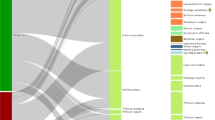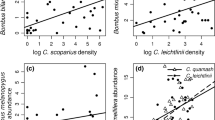Abstract
Anthidium manicatum is an invasive pollinator reaching widespread distribution in North America. Male A. manicatum aggressively defend floral territories, attacking heterospecific pollinators. Female A. manicatum are generalists, visiting many of the same plants as native pollinators. Because of A. manicatum’s rapid range expansion, the territorial behavior of males, and the potential for female A. manicatum to be significant resource competitors, invasive A. manicatum have been prioritized as a species of interest for impact assessment. But despite concerns, there have been no empirical studies investigating the impact of A. manicatum on North American pollinators. Therefore, across a two-year study, we monitored foraging behavior and fitness of the common eastern bumble bee (Bombus impatiens) in response to A. manicatum presence. We found that B. impatiens avoided foraging near A. manicatum in both years; but despite this resource exclusion, we found no evidence of fitness consequences for B. impatiens. These results suggest A. manicatum pose as significant resource competitors, but that B. impatiens are likely able to compensate for this resource loss by finding available resources elsewhere.




Similar content being viewed by others
References
Barfield AS, Bergstrom JC, Ferreira S et al (2015) An economic valuation of biotic pollination services in Georgia. J Econ Entomol 108:388–398. https://doi.org/10.1093/jee/tou045
Burnham KP, Anderson DR (2002) Model selection and multimodel inference, 2nd edn. Springer, New York
Cameron SA, Lozier JD, Strange JP et al (2011) Patterns of widespread decline in North American bumble bees. Proc Natl Acad Sci 108:662–667. https://doi.org/10.1073/pnas.1014743108
Colla SR (2016) Status, threats and conservation recommendations for wild bumble bees (Bombus spp.) in Ontario, Canada: a review for policymakers and practitioners. Nat Areas J 36:412–426. https://doi.org/10.3375/043.036.0408
Colla SR, Packer L (2008) Evidence for decline in eastern North American bumblebees (Hymenoptera: Apidae), with special focus on Bombus affinis cresson. Biodivers Conserv 17:1379–1391. https://doi.org/10.1007/s10531-008-9340-5
Drummond F (2012) Commercial bumble bee pollination of lowbush blueberry. Int J Fruit Sci 12:54–64. https://doi.org/10.1080/15538362.2011.619120
Elbgami T, Kunin WE, Hughes WOH, Biesmeijer JC (2014) The effect of proximity to a honeybee apiary on bumblebee colony fitness, development, and performance. Apidologie 45:504–513. https://doi.org/10.1007/s13592-013-0265-y
Gibbs J, Sheffield CS (2009) Rapid range expansion of the wool-carder bee, Anthidium manicatum (Linnaeus) (Hymenoptera: Megachilidae), in North America. J Kansas Entomol Soc 82:21–29. https://doi.org/10.2317/JKES805.27.1
Goulson D (2003) Effects of introduced bees on native ecosystems. Annu Rev Ecol Evol Syst 34:1–26. https://doi.org/10.1146/132355
Goulson D, Lye GC, Darvill B (2008) Decline and conservation of bumble bees. Annu Rev Entomol 53:191–208. https://doi.org/10.1146/annurev.ento.53.103106.093454
Graham KK, MacLean MG (2018) Presence-only modeling is ill-suited for a recent generalist invader, Anthidium manicatum. Ecol Indic 89:56–62. https://doi.org/10.1016/j.ecolind.2018.02.002
GraphPad Software (2017) GraphPad Prism
Grixti JC, Wong LT, Cameron SA, Favret C (2009) Decline of bumble bees (Bombus) in the North American Midwest. Biol Conserv 142:75–84
Haas A (1960) Vergleichende Verhaltensstudien zum Paarungsschwarm solitärer Apiden. Z Tierpsychol 17:402–416. https://doi.org/10.1111/j.1439-0310.1960.tb00398.x
Jaycox ER (1967) An adventive Anthidium in New York State (Hymenoptera: Megachilidae). J Kansas Entomol Soc 40:124–126
Kenis M, Auger-Rozenberg MA, Roques A et al (2009) Ecological effects of invasive alien insects. Biol Invasions 11:21–45. https://doi.org/10.1007/978-1-4020-9680-8_3
Kenta T, Inari N, Nagamitsu T et al (2007) Commercialized European bumblebee can cause pollination disturbance: an experiment on seven native plant species in Japan. Biol Conserv 134:298–309. https://doi.org/10.1016/j.biocon.2006.07.023
Nakagawa S, Schielzeth H (2013) A general and simple method for obtaining R2 from generalized linear mixed-effects models. Methods Ecol Evol 4:133–142. https://doi.org/10.1111/j.2041-210x.2012.00261.x
Pechuman LL (1967) Observations on the behavior of the bee Anthidium manicatum (L.). J N Y Entomol Soc 75:68–73
Pelletier L, McNeil JN (2003) The effect of food supplementation on reproductive success in bumblebee field colonies. Oikos 103:688–694
R Core Team (2016) R: a language and environment for statistical computing
Ricciardi A, Hoopes M, Marchetti M, Lockwood J (2013) Progress toward understanding the ecological impacts of nonnative species. Ecol Monogr 83:263–282. https://doi.org/10.1890/13-0183.1
Russo L (2016) Positive and negative impacts of non-native bee species around the world. Insects 7:69. https://doi.org/10.3390/insects7040069
Severinghaus LL, Kurtak BH, Eickwort GC (1981) The reproductive behavior of Anthidium manicatum (Hymenoptera: Megachilidae) and the significance of size for territorial males. Behav Ecol Sociobiol 9:51–58. https://doi.org/10.1007/BF00299853
Soper J, Beggs J (2013) Assessing the impact of an introduced bee, Anthidium manicatum, on pollinator communities in New Zealand. N Z J Bot 51:213–228. https://doi.org/10.1080/0028825X.2013.793202
Starks PT, Reeve HK (1999) Condition-based alternative reproductive tactics in the wool-carder bee, Anthidium manicatum. Ethol Ecol Evol 11:71–75
Strange JP, Koch JB, Gonzalez VH et al (2011) Global invasion by Anthidium manicatum (Linnaeus) (Hymenoptera: Megachilidae): assessing potential distribution in North America and beyond. Biol Invasions 13:2115–2133. https://doi.org/10.1007/s10530-011-0030-y
Thomson D (2004) Competitive interactions between the invasive European honey bee and native bumble bees. Ecology 85:458–470. https://doi.org/10.1890/02-0626
Thomson DM (2006) Detecting the effects of introduced species: a case study of competition between Apis and Bombus. Oikos 114:407–418
U.S. Fish and Wildlife Service (2017) Rusty patched bumble bee Bombus affinis
Weissmann JA, Picanço A, Borges PAV, Schaefer H (2017) Bees of the Azores: an annotated checklist (Apidae, Hymenoptera). Zookeys 642:63–95. https://doi.org/10.3897/zookeys.642.10773
Williamson M, Brown K (1986) The analysis and modelling of British invasions. Philos Trans R Soc B 314:505–522. https://doi.org/10.1098/rstb.2010.0098
Wilson ME, Skinner JA, Wszelaki AL, Drummond F (2016) Plant-insect interactions using nonmetric multidimensional scaling to analyze bee visitation in east tennessee crops as an indicator of pollination services provided by honey bees (Apis mellifera L.) and native bees. Environ Entomol 45:390–396. https://doi.org/10.1093/ee/nvv216
Wirtz P, Szabados M, Pethig H, Plant J (1988) An extreme case of interspecific territoriality: male Anthidium manicatum (Hymenoptera, Megachilidae) wound and kill intruders. Ethology 78:159–167
Acknowledgements
We thank Sean Boyden, Kevin Lindell, Luke O’Connor, and Luca Guadagno for their help with field site maintenance and data collection.
Funding
This project was funded through the National Science Foundation Research Experience for Undergraduates (2015: NSF DBI 1263030, 2016: NSF DBI 1560380; Awarded to PS), Sigma Xi Grants-in-Aid of Research (ID: G20141015702880; Awarded to KG), Tufts Graduate Student Research Competition (2014 & 2016; Awarded to KG); Tufts Summer Scholars Program (Awarded to IO), and generous donations from project backers through Experiment.com (https://doi.org/10.18258/5029; Awarded to KG).
Author information
Authors and Affiliations
Contributions
K.K.G. conceived of the experiment and methods, did data collection, data analysis and manuscript preparation. K.E. and I.O. assisted with data collection. P.S. advised on methods, data interpretation and edited the manuscript.
Corresponding author
Ethics declarations
Conflict of interest
The authors have no conflicts of interest to report.
Electronic supplementary material
Below is the link to the electronic supplementary material.
Rights and permissions
About this article
Cite this article
Graham, K.K., Eaton, K., Obrien, I. et al. Anthidium manicatum, an invasive bee, excludes a native bumble bee, Bombus impatiens, from floral resources. Biol Invasions 21, 1089–1099 (2019). https://doi.org/10.1007/s10530-018-1889-7
Received:
Accepted:
Published:
Issue Date:
DOI: https://doi.org/10.1007/s10530-018-1889-7




